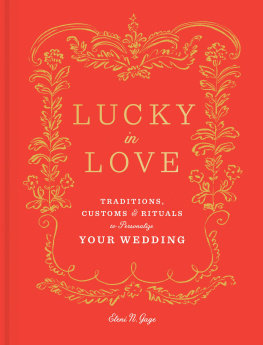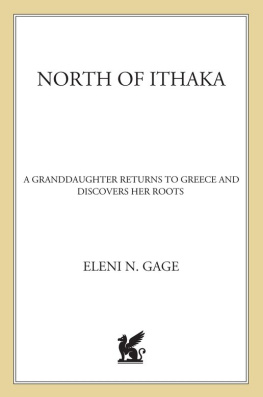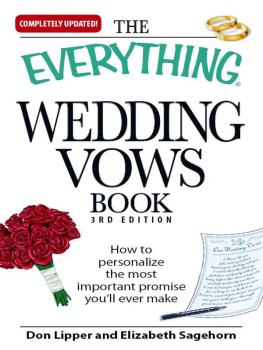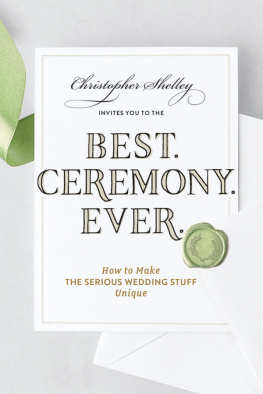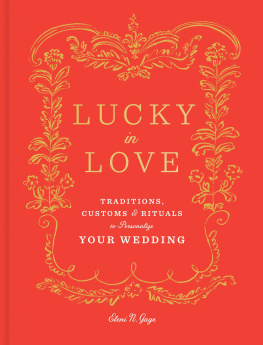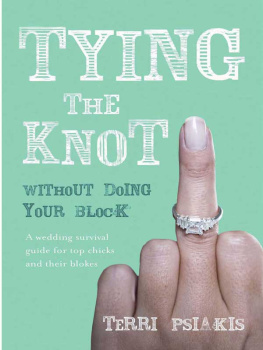Contents
Acknowledgments
Folklore has so much to teach us, but its greatest lesson is that none of us lives in a vacuum. Supportive communities make lifes joys richer and sorrows bearable. And the support of countless friends, relatives, and colleagues made this book possible.
First, thanks to my aunts for reading my future in coffee grounds; Eleni Nikolaides, for wrapping all the bonbonnires for my wedding and filling my life with love; and to my parents, sister Marina, cousin Efrosini, and my cousins on Corfu and new relatives in Nicaragua for throwing me not one but two weddings (in the same day!). Thanks to my husband, Emilio, our children, Amalia and Nico, and their cousin, Stone, for three great baptisms; and my friends for the everyday rituals and celebrations that give life meaning.
Friends from a multitude of cultures provided both the inspiration for, and the fact checking of, many rituals in this book. Notable among them are Neela Pania and Vimla Pania, who discussed Hindu theology at length; Katherine Fausset and Kay Fausset, who gave me the tip about burying bourbon that inspired me to inter an airplane nip of brandy at the Corfu Sailing Club; and Rachel Gogos, my web guru and soul sister.
Many thanks to my former colleagues at Martha Stewart Weddings, for feeding my obsession with nuptials, teaching me so much, and encouraging me in this processand for publishing my story that was the original inspiration for this book. Specifically, thanks to Michael McCormack for your support, design advice, and generally being in the room where it happened; Jen Cress for your intel and enthusiasm; Amy Conway for the assignment; Darcy Miller, who shows us all how to celebrate everything; and Elizabeth Graves for being a constant source of friendship and inspiration.
It takes a village to raise a book, and my editor Amanda Englander and her assistant, Gabrielle van Tassel, have been wonderful godparents. Thanks, too, to Terry Deal, Jenny Jimenez, and Mia Johnson at Clarkson Potter. Emily Isabellas artwork brought the beauty of these rituals to life in a way words alone never could. My agent, Stphanie Abou, is the first person I told about this idea. She responded with all the support I have now come to expect from her. Stphanie, finding you was bashert. Last, but definitely not least, thanks to Jenny Zamora, for nurturing my children while I wrote this.
And to everyone whose wedding I danced at, or who danced at mine: thanks for sharing the joy. You make me feel very lucky indeed.
Works Referenced
Allen, Kimberly Burton. Wedding Wonder: Tales & Traditions, Customs & Curiosities. Glendale Heights, IL: Great Quotations Publishing Company, 1967.
Arnold, Elliott. Blood Brother. Lincoln: University of Nebraska Press, 1979 (first published 1947).
BenShea, Noah. A World of Ways to Say I Do: Wedding Vows, Readings, Poems, and Customs from Different Traditions and Cultures. New York: McGraw Hill, 2005.
Cerullo, Christina. The Brides Pocket Guide to Wedding Customs and Superstitions. Brookfield, CT: Sinematrix, 2011.
Dundes, Alan. The Study of Folklore. Englewood Cliffs, NJ: Prentice-Hall, Inc., 1965.
Editors of Martha Stewart Weddings. Martha Stewart Weddings: Ideas and Inspiration. New York: Clarkson Potter/Publishers, 2015.
Elleven, Russell K. Reverent Rituals: A Brief Wedding Guide. New York: iUniverse, 2003.
Fitzgerald, F. Scott. F. Scott Fitzgerald: A Life in Letters: A New Collection Edited and Annotated by Matthew J. Bruccoli. New York: Scribner, 1995.
Goodridge, Hillary. Hillary Goodridge & others vs. Department of Public Health & another, Supreme Judicial Court of Massachusetts, November 18, 2003, available at caselaw.findlaw.com/ma-supreme-judicial-court/1447056.html.
Gourse, Leslie. Native American Courtship and Marriage Traditions. New York: Hippocrene Books, 1995.
Homer and Alexander Pope. The Iliad. Seattle: Amazon Classics, 2017.
Ingpen, Robert R., and Philip Wilkerson. A Celebration of Customs and Rituals of the World. New York: Facts on File, 1996.
Jones, K. C. Fortune-Telling Book for Brides. San Francisco: Chronicle Books, 2009.
Jones, Leslie. Happy Is the Bride the Sun Shines On: Wedding Beliefs, Customs, and Traditions. New York: McGraw-Hill Education, 1995.
The New American Bible, Revised Edition. New York: HarperCollins Pub,lishers, 2012.
Oring, Elliott, ed. Folk Groups and Folklore Genres: A Reader. Logan: Utah State University Press, 1989.
Roney, Carley. The Knot Guide to Wedding Vows and Traditions: Readings, Rituals, Music, Dances, and Toasts. New York: Clarkson Potter/Publishers, 2013.
Rouvelas, Marilyn. A Guide to Greek Traditions and Customs in America. Bethesda, MD: Attica Press, 1993.
Schultz, Christine. Why Are Wedding Dresses White? The Old Farmers Almanac. Dublin, NH: Yankee Publishing, 2018.
Spangenberg, Lisl M. Timeless Traditions: A Couples Guide to Wedding Customs Around the World. New York: Universe, 2001.
Thomas, Daniel Lindsey, and Lucy Blayney. Kentucky Superstitions. Princeton: Princeton University Press, 1920.
Tresiddor, Jack. 1,001 Symbols: An Illustrated Guide to Imagery and Its Meaning. San Francisco: Chronicle Books, 2004.
Various Authors. Every Womans Encyclopaedia. London, UK: London S.N., 19101912.
Warne, Frederick. Flower Fairies. The Meaning of Flowers: Folklore, Fairylore, Superstitions, Remedies. London, UK: Penguin Books, 1996.
RULES OF ENGAGEMENT
Starting Off on the Right Foot
Chances are, the instant you decided youd be together forever was a private one. Even if there was a classic down-on-one-knee proposal in public, its likely to have come after the bolts of lightning and quiet moments when you realized youd found someone who supports you and delights you and will do so for as long as you both shall live. But once your engagement becomes official and you choose to kick off your future with a wedding, your private promise becomes a public cause for celebrationone with several visible symbols.
ROMANCING THE STONE
A ring has represented the promise of a marriage since ancient times. Roman suitors were the first on record to give their intended brides annuli pronubi, betrothal rings, as a tangible marker that the woman now belonged to her fianc. If you dont like the one-way indication of a woman belonging to a man, consider a ring for the groom as well. South Asian Muslims often exchange betrothal rings, which are worn on the right hand by the man and the left by the woman. In Argentina, couples who are on their way to being engaged exchange silver rings called alianzas de plata, then up the ante with alianzas de oro, gold rings, when they make the engagement officiala custom that works well with same-sex couples, too. Its only during the wedding ceremony that an Argentinian groom gives the bride a diamond ring called a cintillo; he continues to wear his gold band. And in Orthodox Christian countries, such as Greece and Russia, where the wedding ring is traditionally worn on the right hand, some couples place their bands on their left hands when they get engaged, then move them to the right during the wedding. You could reverse the order if you plan on wearing your band on your left hand, or use this custom as precedent for the groom-to-be to start wearing his band when the bride-to-be puts on her engagement ring. And if one or both of you arent jewelry-wearers, you might adopt the Polynesian tradition of getting a tattoo to symbolize a significant event, or combine the custom of a significant tattoo with the idea of a ring by having a design inked on your fourth finger.

